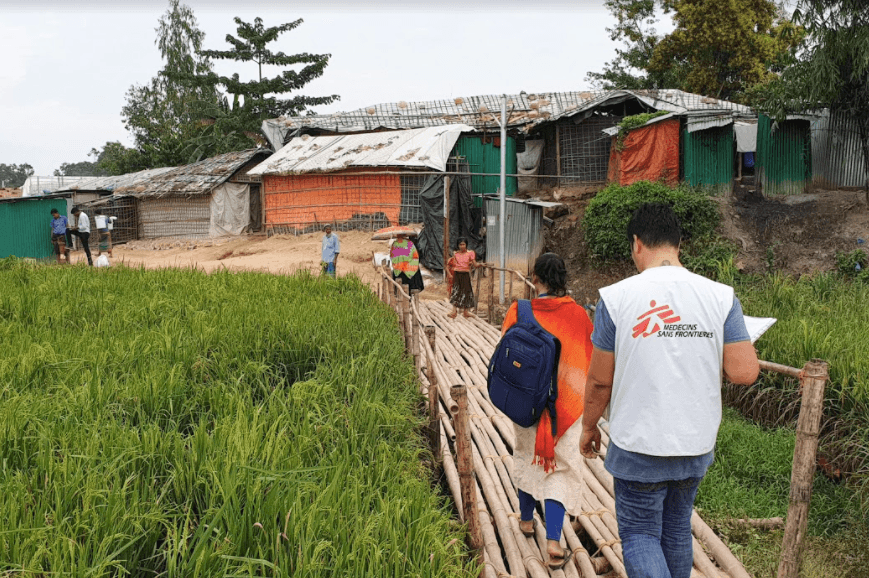SUMMARY
This is AI generated summarization, which may have errors. For context, always refer to the full article.


More than 70 million people worldwide have been forcibly displaced for many reasons: war, persecution, conflict, natural disaster, destitution, and repression. Half of the world’s refugees and displaced are children.
The world’s largest refugee settlement is right in our backyard – Cox’s Bazar district in Bangladesh. Over 900,000 Rohingya people have lived in the district’s numerous camps for almost two years now since the mass exodus in 2017. They remain vulnerable to serious health risks like infections, outbreaks, and psychiatric conditions.
It might be hard to imagine how it’s like to be a refugee. Fortunately, two Filipino nurses who served in projects for Médecins Sans Frontières (MSF) in Bangladesh documented their day-to-day interactions with them. Through their photos and words, Jose Vincent and Darwin hope to show how they improvised to deliver free and quality medical care in a challenging setting.

We typically receive more patients at the beginning and end of the week, which are Sundays and Thursdays in Bangladesh. We see an average of 500 Rohingya refugees and Bangladeshi patients every day at the 3 MSF primary healthcare centers located in Jamtoli camp, a smaller camp beside the huge Kutupalong-Balukhali megacamp. We have to manage the influx of patients to be efficient.

Due to the high number of patients coming to our centers every day, our staff were trained to do proper triaging or sorting to prioritize patients according to their needs. They also take vital signs and guide patients on what to do next. This keeps the flow of people organized and manageable.

Poor hygiene and sanitation greatly affect the quality of life in refugee camps. Common diseases among many of our patients include acute watery diarrhea, upper respiratory tract infection, and skin diseases. In overcrowded and poorly ventilated conditions, outbreaks like diphtheria and chickenpox can occur and spread very quickly. A number of vaccination campaigns were already done across the camp but so long as living conditions remain poor, the risk of a potential outbreak remains.

Clean water is essential for good health and sanitation. The simple practices of drinking clean water, washing one’s hands, and using a well-maintained toilet can prevent a lot of the diseases we treat. Our colleagues – especially our water engineers and sanitation experts – work with the community to install and maintain water and sanitation infrastructure, and to educate people on how to maintain good hygiene practices. The megacamp is a few kilometers wide and virtually every area has a refugee shelter.

Trucks traverse the camp carrying heavy loads of bamboo that are used to build structures, including temporary shelters and health facilities. This truck was in front of our vehicle and tipped over due to the muddy rough road.

The makeshift shelters in the refugee camp sit on top of a hilly landscape. Landslides happen frequently, especially during the rainy season. In our health facilities, as in the other structures in the camp, sandbags reinforce our fences and serve as improvised protection from floods and landslides. We also set up temporary bridges using bamboo and sandbags so our patients can reach our facilities.

A Rohingya patient named Abul Kalam had a wound for two years before we first saw him. Due to misuse of medicines, he developed antibiotic resistance. He also tried to relieve the pain by persistently scratching or cutting scabs over his wound. Our team made sure to continuously follow up on his case so he received proper treatment.
We also made a crutch out of wood for Abul Kalam. We covered it with cotton and bandages and fixed it with elastic tape. This helped him walk around without exposing his affected foot to mud and dirty water. He recovered quickly.

A beautiful sunset over Jamtoli camp calms us after another busy day. Most of the time, we feel there’s more work to be done. Other days, however, we know that small and big efforts alike bring us closer to providing the best quality of care possible for the community. – Rappler.com
Jose Vincent Pagarugan and Darwin Diaz are members of Médecins Sans Frontières. They are both working at the Jamtoli camp in Cox’s Bazar District in Bangladesh.
Add a comment
How does this make you feel?
There are no comments yet. Add your comment to start the conversation.